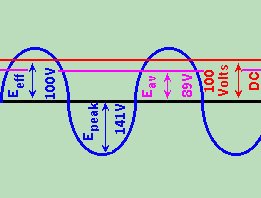


ACK! It's A.C. !!!But with AC, Voltage becomes more difficult to define. Looking at an AC wave, we actually have 3 different voltages to compare. The voltage from the 0 line to the positive peak of the AC curve is called the PEAK VOLTAGE. If we measure the Voltage from the top of the positive peak, to the bottom of the Negative peak, we call it the PEAK TO PEAK VOLTAGE, which is equal to 2 times the peak voltage. Finally, when we try to do work with an AC Voltage, we find out that a 10 Volt peak voltage wont turn a motor as fast as a 10 Volt DC Voltage. Reason? Because 10 Volts DC is 10 Volts all the time. A 10 Volt peak AC Voltage is only 10 Volts for an instant. The rest of the time it is swinging higher and lower in Voltage level. So at what Voltage level does the AC wave do as much work as a pure DC Voltage? 
Often, electricians and electronics technicians find that they need to be able to convert AC voltages to DC voltages. They need to know what the effective voltage is. Based on the 141:100 ratio of AC to DC, the following formulae were conceived:   Just when you thought it was safe to get back into the water, I'm gonna throw one more formula at you. What happens if we take all the instantaneous voltage values of a sine wave, add them all up, and then take the average of them? Well, it doesn't quite come up to the effective voltage. When working with rectifier circuits (we'll discuss them in a later section), we must sometimes use what is known as the AVERAGE VOLTAGE of a given AC sine wave. The average voltage is found by the following formula:  |
| (On The Following Indicator... PURPLE will indicate your current location) | ||||||||||||||||||||||||
| 1 | 2 | 3 | 4 | 5 | 6 | 7 | 8 | 9 | 10 | 11 | 12 | 13 | 14 | 15 | 16 | 17 | 18 | 19 | 20 | 21 | 22 | 23 | 24 | 25 |
| 26 | 27 | 28 | 29 | 30 | 31 | 32 | 33 | 34 | 35 | 36 | 37 | 38 | 39 | 40 | 41 | 42 | 43 | 44 | 45 | 46 | 47 | 48 | 49 | 50 |
| 51 | 52 | 53 | 54 | 55 | 56 | 57 | 58 | 59 | 60 | 61 | 62 | 63 | 64 | 65 | 66 | 67 | 68 | 69 | 70 | 71 | 72 | 73 | 74 | 75 |
| Otherwise - please click to visit an advertiser so they know you saw their ad! |
